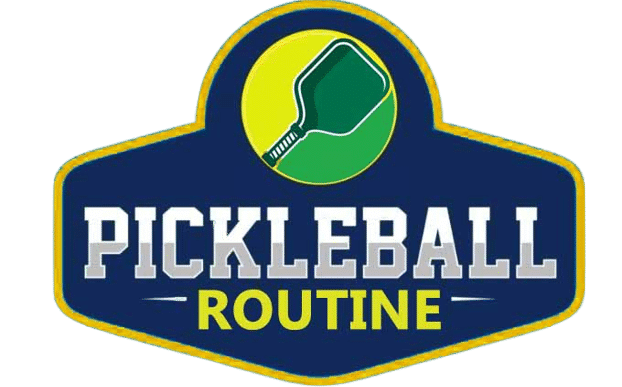Pickleball is a lively paddle sport that blends the techniques of tennis, badminton, and table tennis. It’s easy to learn, fast to play, and welcoming for people of every age and skill level. Officially governed by USA Pickleball (USAP), the game follows a standardized set of rules that keep play fair and exciting.
Pickleball blends tennis and badminton logic into a rally that rewards control, not power. A match unfolds on a 20-by-44-foot court where singles or doubles players trade serves diagonally from behind the baseline. Each rally begins with two bounces—one per side—before volleys start, keeping play balanced. Only the serving team scores, chasing 11 points and a two-point margin. The “kitchen,” a seven-foot buffer near the net, forbids volleying to prevent smash dominance.
Serves must stay underhand, below the waist, and clear the net into the proper service box. Faults arise from stepping into the kitchen mid-volley, missing bounds, or hitting twice. Paddles, made from wood or composite, strike a perforated plastic ball, and games rely on clear calls and courteous conduct. The rhythm of the sport lives in patience, precision, and the pause before the bounce.
What are the basic rules of Pickleball?
Pickleball follows a simple set of rules designed to keep the game fast and fair. Players serve underhand from behind the baseline, sending the ball diagonally into the opposite service court. Each rally begins with the double bounce rule, meaning the ball must bounce once on each side before volleys are allowed. Only the serving team scores points, and games are usually played to 11 points, with a win-by-2 condition.
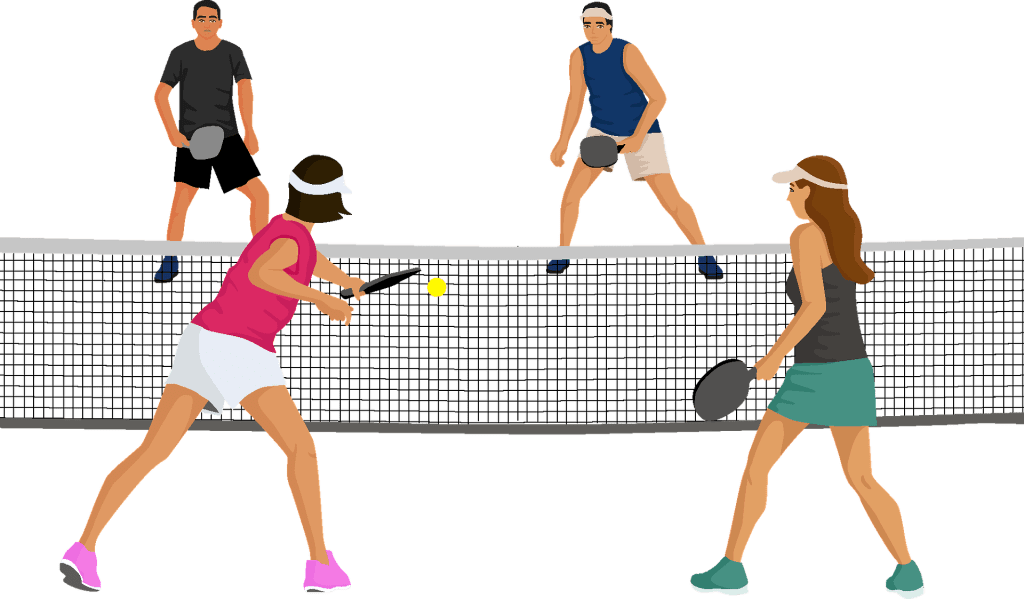
Players must avoid volleying while standing in the non-volley zone, or “kitchen,” which stretches seven feet from the net. Common faults include serving out of bounds, volleying in the kitchen, or missing the ball before it bounces once. These basics create a balanced rhythm of strategy, timing, and light-footed play.
How to Serve in Pickleball?
Serving in pickleball follows a few precise mechanics that keep every rally fair and consistent. The following rules outline how a proper serve is executed:
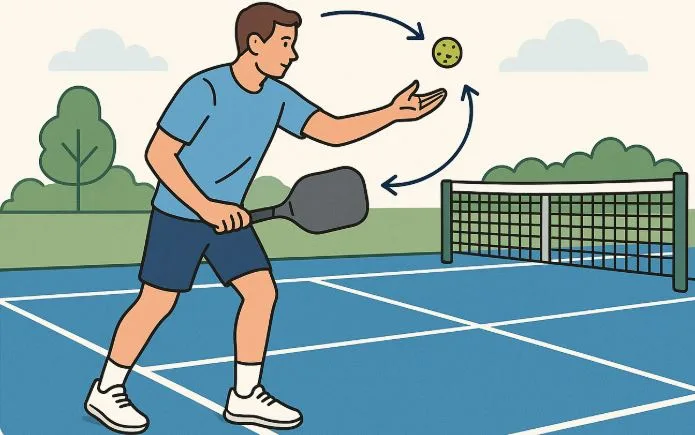
- Upward motion: The server’s arm moves in an upward arc during contact.
- Below waist hit: The paddle must strike the ball below the server’s waist.
- Wrist position: The paddle head stays below the highest point of the wrist.
- Drop serve option: Players may drop the ball and hit it after the bounce; in this method, paddle and arm restrictions do not apply.
- Foot placement: At least one foot remains behind the baseline, and neither foot touches the court or crosses the sideline or centerline extension.
- Diagonal serve: The serve travels diagonally across the court and must land within the opposite service box.
- Single attempt: Each server gets only one chance to deliver a valid serve.
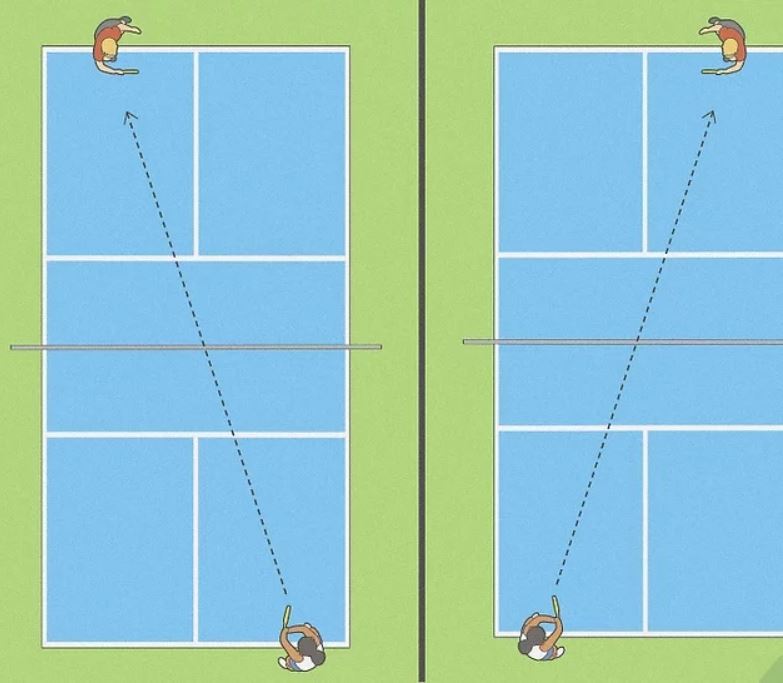
What is the Service Sequence in Pickleball?
The service sequence in pickleball follows a specific rotation that keeps play organized and fair. At the start of a game, only one player from the serving team begins—this is called the first serve sequence. After that, both players on each team get a turn to serve before the ball switches sides.
In doubles, the player on the right-hand court serves first, sending the ball diagonally to the opponent’s right-hand service box. When that server loses a point, the partner takes over the serve from the left-hand court. Once both players have served and lost their rallies, the serve moves to the opposing team.
In singles play, the server switches sides after each point, serving from the right when their score is even and from the left when it’s odd. This rotation keeps scoring orderly and ensures every player serves under equal conditions.
What is the Double Bounce Rule in Pickleball?
The Double Bounce Rule in pickleball ensures fair play and balanced rallies right from the serve. After the ball is served, it must bounce once on each side before either team starts volleying (hitting the ball in the air). This means the receiving team must let the serve bounce before returning it, and then the serving team must let that return bounce before striking back.
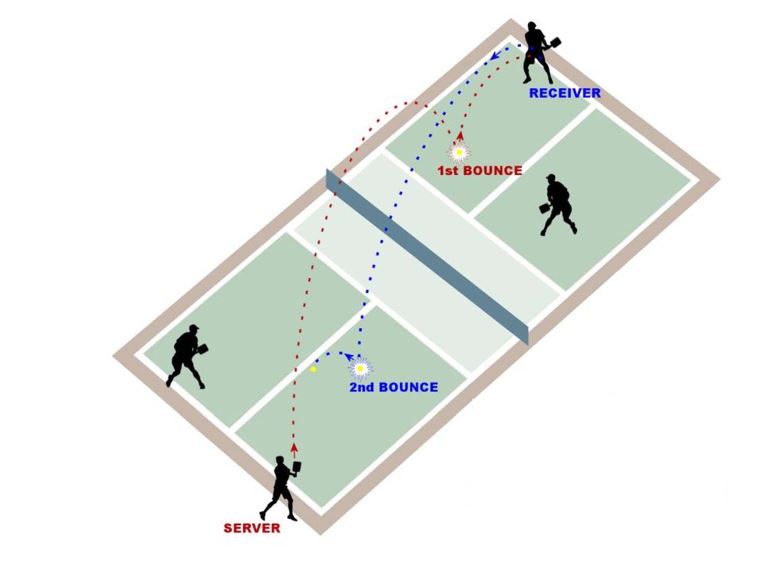
What are the Scoring Rules in Pickleball?
Scoring in pickleball follows a structured pattern that rewards the serving team and keeps rallies competitive. Points are scored only by the serving side, and games are typically played to 11 points, with a win-by-2 requirement. In tournament play, matches may extend to 15 or 21 points under the same win condition.
In doubles, both partners serve before the ball switches to the other team—a process known as a side-out. The server always starts from the right-hand court when the score is even and the left-hand court when the score is odd. Scores are called in three numbers: the serving team’s score, the receiving team’s score, and the server number (1 or 2).
In singles, each player serves from the right on even scores and the left on odd scores, alternating sides after every point. This system ensures clarity, balance, and rhythm in every game, where strategy and consistency decide the outcome.
| Aspect | Description |
|---|---|
| Who Scores Points | Only the serving team scores during a rally. |
| Winning Score | Standard games are played to 11 points, and a team must win by 2. |
| Tournament Scoring | Competitive matches may extend to 15 or 21 points, with the same win-by-2 rule. |
| Doubles Format | Both partners on a team serve before a side-out occurs and service passes to the opponents. |
| Service Order | The first server starts from the right-hand court and alternates sides after each point won. |
| Score Calling Format | Scores are called as three numbers — serving team’s score, receiving team’s score, and server number (1 or 2). |
| Singles Format | The server serves from the right court on even scores and the left court on odd scores, alternating after each point. |
| Side-Out Rule | A side-out happens when the serving team loses both serves (in doubles), giving serve control to the opponents. |
What is the Non-Volley Zone in Pickleball?
The Non-Volley Zone, often called the kitchen, is the seven-foot area on both sides of the net where players are not allowed to volley the ball. A volley means hitting the ball out of the air before it bounces. Players may enter the kitchen only to play a ball that has already bounced, but they must exit before volleying again. Stepping on or over the kitchen line during a volley counts as a fault. This rule prevents dominant smashes at the net and keeps rallies more strategic and controlled.
What Are Faults in Pickleball and When Do They Occur?
A fault is any action that stops play due to a rule violation. Faults occur when:
- The serve lands out of bounds or in the non-volley zone.
- A player volleys in the kitchen or steps on the line during a volley.
- The ball fails to clear the net.
- A player hits the ball twice or before it bounces once after serving.
- The ball bounces twice on one side before being returned.
Faults cause the serving team to lose the rally or, in doubles, transfer the serve to the partner or opponent through a side-out.
How are Line Calls Made in Pickleball?
Line calls in pickleball depend on player honesty and visibility. A ball that touches any part of the line, except the non-volley zone line on a serve, is considered in. Only the receiving team makes line calls on their side of the court. If there’s any uncertainty, the benefit of the doubt goes to the opponent—a principle that preserves sportsmanship. In tournaments, referees may assist with disputed calls, but in recreational play, clear communication and fairness guide the decision.
How Is the Serving Team Determined in Pickleball?
At the start of a game, the serving team is chosen by a coin toss, rally, or mutual agreement. The winning side decides whether to serve or receive first. The first server always starts from the right-hand court, and only one player serves before a side-out occurs—this is called the first serve sequence. After that, in doubles play, both teammates serve before the serve switches sides. This structure keeps the start of the game fair and ensures both teams rotate through serving opportunities evenly.
What are 3 things to avoid in the game of Pickleball?
The 3 things to avoid in the game of Pickleball are mentioned below.
- Volleying in the Non-Volley Zone (Kitchen): Never hit the ball in the air while standing in or touching the kitchen. Enter it only to play a ball that has bounced, then step out before volleying again. Violating this rule counts as a fault and ends the rally.
- Serving or Hitting Out of Bounds: Avoid serves or returns that land outside the court lines. Even a slightly misjudged shot can give away points or service, so aim for control over power.
- Losing Focus on the Double Bounce Rule: Always let the ball bounce once on each side after the serve before volleying. Forgetting this early in the rally is a common beginner mistake that leads to quick faults.
